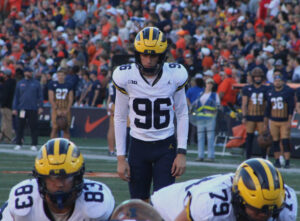The Targeting Rule: scrap it or embrace it

Texas A&M linebacker Otaro Alaka (42) hits Northwestern State safety Ryan Reed (8) with his helmet during a return in the first half of an NCAA college football game Thursday, Aug. 30, 2018, in College Station, Texas. Alaka was called for targeting and ejected from the game. (AP Photo/Sam Craft)
It was implemented to establish safety, protect the players and to limit concussions in today’s game. However, the targeting rule has quickly become a topic of controversy.
There’s a thin line between a legitimate hard hit, and a defender intentionally leading with his helmet to cause harm to an opposing player. The same goes for defenders lunging at a defenseless receivers.
The penalties from these plays have changed all aspects of the game. Replay has helped, but there are times when it seems like even the replay officials don’t get it right.
Only the players suffer, because those penalties mess with their psyche, even when they are overturned in their favor. Now defenders have to think twice before they tackle and it slows down everything. They have only a split second to position themselves to make a play and the speed of the game has become faster.
The Targeting Rule states players who target and hit defenseless opponents above the shoulders are ejected and their team penalized 15 yards. This includes leading or lowering with the crown of the helmet, and launching to the head or neck area with a shoulder or forearm.
If it’s forcible contact the player is done for the entire game. If it happened in the second half the player is ejected and sits out the first half of the teams’ next game. No defender is immune to this call and team captains all the way down to backups have bit the dust to the Targeting Rule.
Accidents happen and sometimes players can be in the wrong place at the wrong time. There are a few dirty players out there who use their helmets as weapons instead of utilizing safety and protecting themselves and others.
Everything can turn ugly quickly when these plays happen and the Florida-Vanderbilt game is a perfect example. Both benches cleared after a brutal crack-back block on a punt return and for a minute it resembled a riot on the field.
No one wants any game to turn for the worse and that’s why there’s been a huge emphasis on the Targeting Rule. Several defensive coordinators have adjusted their techniques they teach their players. That could be challenging for some when for years they taught their defenders to not just run into the man, but run through the man.
The meat grinder of the bowl games are approaching next week and the Targeting Rule should definitely be put under the microscope. There’s a governing body and upper powers that regulates everything, so if there are shady officials out there who abuse the Targeting Rule it won’t go unnoticed.
There’s no denying the Targeting Rule has ticked off thousands of fans across the nation. Some could even argue that it has taken some of the luster out of the sport. Only time will tell if this scrutinized rule has been effective with the overall safety of the sport. In the meantime everyone has no choice but to adapt to it and when the rule is enforced on future players’ collisions, expect the unexpected.







